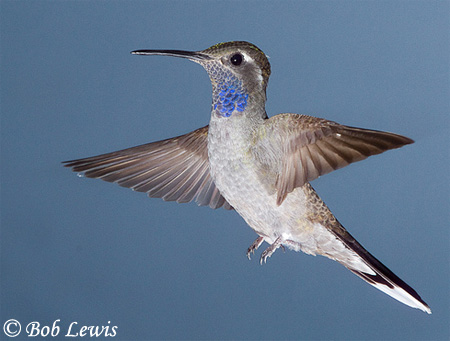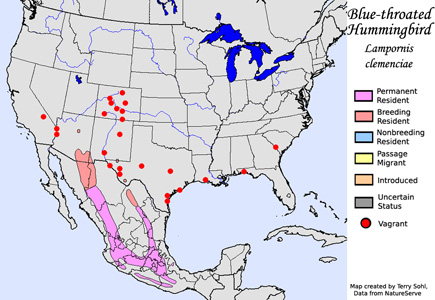| Length: 5 inches | Wingspan: 8 inches | Seasonality: Non-resident in South Dakota |
| ID Keys: Large size (largest U.S. hummingbird), dark blue throat (male), large, broad tail | ||
 The
Blue-throated Hummingbird is the largest hummingbird that visits the United
States. In addition to its size, it is often a very aggressive
hummingbird, and when found with other hummingbird species, it may dominate
prime feeding areas and aggressively defend them against intruders.
Plumage overall is actually rather plain, and even the brilliant blue throat
of the male is difficult to see except in prime lighting situations. The
nests of the Blue-throated Hummingbird are unique for hummingbirds visiting
the United States, with a covering of moss.
The
Blue-throated Hummingbird is the largest hummingbird that visits the United
States. In addition to its size, it is often a very aggressive
hummingbird, and when found with other hummingbird species, it may dominate
prime feeding areas and aggressively defend them against intruders.
Plumage overall is actually rather plain, and even the brilliant blue throat
of the male is difficult to see except in prime lighting situations. The
nests of the Blue-throated Hummingbird are unique for hummingbirds visiting
the United States, with a covering of moss.
Habitat: In the U.S. portion of its range, the Blue-throated Hummingbird is almost always found in shady riparian areas in canyons of southern Arizona. In the Mexico portion of its range, they can also be found in open woodland or shrubby habitats.
Diet: Typical diet of Hummingbirds, feeding heavily on nectar. Insects can comprise a large portion of the diet, and the species can often do well on an insect diet when flowering plants are rare.
Behavior: Bold and aggressive. The large size and aggressive behavior results in Blue-throated Hummingbirds often dominating prime feeding areas, including feeder setups.
Nesting: The nest of the Blue-throated Hummingbird is variable in placement, being found anywhere from near ground level to relatively high in a tree. Nests can be in trees and other vegetation, but are also sometimes placed on man-made structures such as bridges or buildings, or can be placed around a crevice in a cave. The nest is made of plant fibers and spider webs, while the outside of the nest is covered with moss, a unique feature for North American hummingbirds. Nest sites may be re-used for multiple years, with new nests sometimes built right on top of a prior year's nest.
Song: Song of the Blue-throated Hummingbird is a subtle rattling hiss that repeats. Males are more often heard making a loud, clear seeek call, often repeating over and over again.
Migration: Most birds in the United States migrate southward to Mexico in the fall, although occasionally one may be found overwintering in southern Arizona. Birds in the Mexican part of their range are likely permanent residents.
Interactive eBird Map: Click to access an interactive eBird map of Blue-throated Hummingbird sightings
Feeders: Will attend hummingbird feeders
Similar Species: Magnificent Hummingbird, White-eared Hummingbird, Broad-billed Hummingbird
Conservation Status: There are some indications that the range of the species has actually expanded in the United States in recent decades, although its range is still extremely limited. Populations otherwise appear to be stable, but they are potentially susceptible to habitat loss in their main Mexican range.
Further Information: 1) WhatBird - Blue-throated Hummingbird
2) Audubon Guide - Blue-throated hummingbird
3) AvianWeb - Blue-throated Hummingbird
Photo Information: Taken in Portal, Arizona - Photo by Bob Lewis
Additional Photos: Additional Photos Coming Soon!!
| Click below for a higher-resolution map |
 |
| South Dakota Status: Non-resident in South Dakota |
Additional Blue-throated Hummingbird Photos (coming soon!!)
